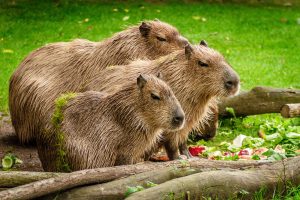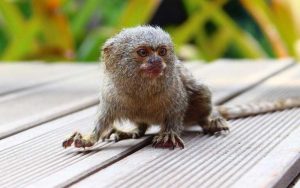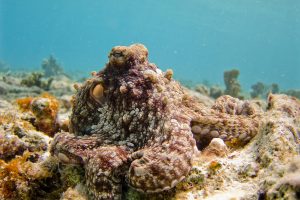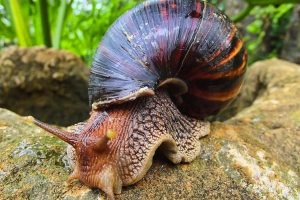10 weird exotic pets you can keep in the UK - Part 2
Here are the weirdest exotic pets you can keep in the UK legally, including tarantulas, fennec fox's and axolotl's.
Read more14 January 2019
The capybara is the world’s largest rodent, weighing between 35-66kg and standing up to 65cm tall at the withers. Although native to the South American savannahs, you can actually keep a Capybara in the UK, however you will need a licence provided by your local council to certify your accommodation and land is sufficient for a Capybara to live in. The capybara is actually a semi-aquatic animal, having webbed feet. So, you will need a swimming pool with ramped access and minimum depth of 3.5 feet, for these giant Guinee pigs.
Capybaras are vegetarians, and in the wild, they graze on grass, making them excellent natural lawnmowers, as well as aquatic plants, fresh fruit and vegetables. You should also feed your capybara hay and cattle pellets and like many rodents their teeth are constantly growing, so providing chewing material like sticks and branches will help naturally prevent dental problems.

Marmosets are primarily found in the tropical rainforests of South America, with a few residual populations in Central America. They can live for up to 18 years, so it’s basically like looking after a child. They are very intelligent creatures and can get bored easily as they usually live in packs forming social structures in the wild. Without this they can become stressed and very unhappy.
Marmosets mainly eat sap and gum from trees, but they also eat the leaves, fruit, seeds and flowers. They may also eat insects, snails, lizards, frogs and baby birds. As these many of these dietary requirements are hard to obtain if living in the UK, there is a lot of controversy over keeping primates legally over here, among other reasons.
The RSPCA is campaigning against keeping primates as pets.

Octopuses can make appealing pets. They’re beautiful and intelligent, and because they can live in an aquarium, they seem like they’d be low-maintenance.
But do they make good pets? Octopuses are intelligent creatures that like to explore their environment and often interact with their human keepers. They can differentiate between humans and will often prefer one more than others. This means they are capable of developing personalities, much like humans.
Others argue that a home aquarium isn’t big enough to keep an Octopus happy, but if you do have a big aquarium, then it’s not so much of an issue. They are big creatures and inevitably need space.
Octopuses are also very sensitive to changes in their water, especially pH balance, and will require a lot of attention. As well as feeding 3 times a day and you can’t pick up Octopus food in your local pet shop; they feed on live critters and frozen krill.

Sugar gliders are popular exotic pets. They’re small, cute, and unique little animals. But just as you would with any other exotic pet, a potential sugar glider owner should be aware of the care requirements and personality traits of a sugar glider before getting one. Having a sugar glider as a pet is a long-term commitment. They require a special diet, lots of attention, and space.
Sugar gliders can make endearing, playful, and entertaining pets but regular human interaction is very important if you want your glider to be friendly, especially if you have a colony of them. Sugar gliders will bond to other gliders that they live with. While these glider relationships are very important, you’ll still want to make sure your glider is also friendly with you if you want to handle it.
A cage 24 inches wide by 24 inches deep by 36 inches high is a good minimum size for a pair of sugar gliders. Bigger is always better when it comes to housing a glider and the height is more valuable than the floor space due to the gliding activity.
In the wild, a sugar glider’s diet includes nectar and sap from trees. Sugar gliders are omnivorous, so in addition to the nectar and sap, they will also eat both plant material and meat including fruit, insects, and even small birds or rodents.

The shell of the giant African snail reaches up to 7.8 inches in length and 2.7-3.9 inches in height. An adult weighs about 32 grams, that’s nearly the weight of a tennis ball.
These snails can be housed in a variety of containers, depending upon the size and number of snails that you have. A good container is a glass or plastic aquarium tank. These types of containers allow easy cleaning and you will be able to watch your snails through the sides. The snails like to burrow, so when you have your tank, fill it with several centimetres of peat-free compost and a large piece of bark.
Keep your snail warm. Snails are happiest in temperatures of about 21 degrees Celsius The best way to achieve a warmer temperature is to place a heating pad under half of the snail’s tank. You should only place it under half the tank, so the snail has somewhere to go to cool down if need be.
In the UK it is perfectly legal to keep giant snails, however Giant African land snails are considered to be an invasive species that could significantly affect the ecosystem of your local area if released into the wild, decimating greenery and removing food sources from our native snails.

British Pet Insurance Services offers a range of exotic pet cover levels, insuring; lizards, snakes, tortoises, parrots, birds of prey and small mammals. With up to £5,000 vet fees and a range of optional extras, select the level of cover to suit your needs.
Get a quote today